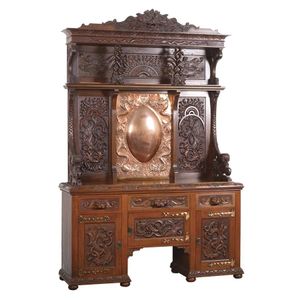19th Century Walnut Equestrian Hall Stand
You must be a subscriber, and be logged in to view price and dealer details.
Subscribe Now to view actual auction price for this item
When you subscribe, you have the option of setting the currency in which to display prices to $Au, $US, $NZ or Stg.
- Turning - Any part of a piece of furniture that has been turned and shaped with chisels on a lathe. Turned sections include legs, columns, feet, finials, pedestals, stretchers, spindles etc. There have been many varieties and fashions over the centuries: baluster, melon, barley-sugar, bobbin, cotton-reel, rope-twist, and so on. Split turning implies a turned section that has been cut in half lengthwise and applied to a cabinet front as a false decorative support.
- Pediment - The uppermost section of a tall usually double-heightened piece of cabinet furniture, surmounting the cornice. The pediment can take a variety of forms derived from the architecture of classical antiquity. A broken pediment is of triangular shape, however, the two raised sides do not meet at the apex but are 'broken' the gap between them often ornamented with an urn or finial. Swan-neck pediments are of similar form, although the uprights are gracefully arched, resembling a swan's neck. They are often found, for example, on longcase clocks.
- Panels - Timber pieces, usually of well-figured wood either recessed or applied over the frames of doors and as decoration elsewhere in the carcase of cabinet furniture. The panels may take a variety of shapes rectangular, square, shield shape, oval, half-round or in the form of Egyptian pylons.
This item has been included into following indexes:
Visually similar items

The Elmslie Sideboard. An oak and Kauri New Zealand Arts and Crafts sideboard with carving and copper repousse work by Jessie Campbell (nee Elmslie). Width 185 cm. Height 256 cm

An impressive double pedestal satinwood writing desk, English, 19th century, 134 cm high, 166 cm high and 69 cm deep

A Swiss music box, Stella, 19th century, upright 26 inch disc music box with base. Coin operated, with 14 discs. Inlaid base, 240 cm high, 82 cm wide, 49 cm deep

A Colonial Australian cedar sideboard, full cedar secondaries, from the workshop of James Whitesides of Hobart, circa 1840, 148 cm high, 214 cm wide, 72 cm deep
